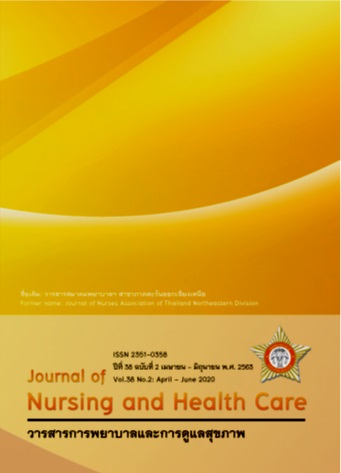ความชุกของภาวะหลอดเลือดผิดปกติของผู้สูงอายุที่เข้ารับการรักษาที่คลินิกความดันโลหิตสูง โรงพยาบาลคำเขื่อนแก้ว จังหวัดยโสธร
คำสำคัญ:
คำสำคัญ: ความชุก ความดันโลหิตสูง หลอดเลือดผิดปกติ ผู้สูงอายุบทคัดย่อ
ค่าความแตกต่างของความดันโลหิตซีสโตลิกระหว่างแขนทั้งสองข้างเป็นตัวแปรอย่างง่ายที่ถูกพัฒนาขึ้นเพื่อเป็นดัชนีชี้วัดทางสุขภาพ รวมถึงใช้บ่งบอกความผิดปกติของหลอดเลือด การศึกษาครั้งนี้จึงมีวัตถุประสงค์เพื่อสำรวจความชุกของภาวะหลอดเลือดแดงผิดปกติที่ประเมินจากค่าความแตกต่างของความดันโลหิตซีสโตลิกระหว่างแขนทั้งสองข้าง การวิจัยนี้เป็นการศึกษาแบบภาคตัดขวาง กลุ่มตัวอย่างคือผู้สูงอายุที่เข้ารับการรักษาที่คลินิกความดันโลหิตสูงที่โรงพยาบาลคำเขื่อนแก้ว จังหวัดยโสธร จำนวน 140 ราย เก็บข้อมูลในช่วงเดือนเมษายน – ธันวาคม 2561 ประเมินข้อมูลพื้นฐานและความดันโลหิตในแขนทั้งสองข้างแบบสุ่มลำดับ ข้างละ 3 ครั้ง จากนั้นหาค่าเฉลี่ย ค่าความแตกต่างของความดันโลหิตรายงานด้วยค่าความแตกต่างสัมบูรณ์ [ค่าความดันโลหิตซีสโตลิกของแขนข้างที่มากกว่า - ค่าความดันโลหิตซีสโตลิกของแขนข้างที่น้อยกว่า] วิเคราะห์ข้อมูลโดยใช้สถิติเชิงพรรณนา และสถิติ Pearson Correlation Coefficient เพื่อพิจารณาความสัมพันธ์ระหว่างค่าความแตกต่างของความดันโลหิตซีสโตลิกระหว่างแขนทั้งสองข้างและคุณลักษณะของอาสาสมัคร ผลการศึกษาพบว่า ผู้สูงอายุอายุเฉลี่ย 72.44 ± 6.22 ปี เป็นเพศชายจำนวน 70 ราย (50.00%) ส่วนใหญ่ถนัดแขนข้างขวา พบความชุกของภาวะหลอดเลือดผิดปกติเท่ากับร้อยละ 35.71 และ 7.85 อ้างอิงตามจุดตัดความแตกต่างของค่าความแตกต่างของความดันโลหิตซีสโตลิกระหว่างแขนทั้งสองข้างที่ ³ 5 และ ³ 10 มิลลิเมตรปรอทตามลำดับ โดยเมื่อวิเคราะห์ความสัมพันธ์พบว่าระดับความดันโลหิตในขณะพักและเส้นรอบวงแขนมีความสัมพันธ์กับค่าความแตกต่างของความดันโลหิตซีสโตลิกระหว่างแขนทั้งสองข้าง จากผลการศึกษาดังกล่าวจึงเป็นข้อมูลสนับสนุนความสำคัญในการประเมินความดันโลหิตในแขนทั้งสองข้างตามมาตรฐานการประเมินจากสมาคมความดันโลหิตสูง และอาจนำการประเมินความดันโลหิตในแขนทั้งสองข้างไปประยุกต์ใช้เพื่อเป็นตัวแปรอย่างง่ายเพื่อติดตามสภาวะหลอดเลือดของผู้สูงอายุในชุมชน
Downloads
เอกสารอ้างอิง
2. Weinberg I, Gona P, O'Donnell CJ, Jaff MR, Murabito JM. The systolic blood pressure difference between arms and cardiovascular disease in the Framingham Heart Study. The American journal of medicine. 2014; 127(3):209-15.
3. Hwang HJ, Sohn IS, Kim DH, Park CB, Cho JM, Kim CJ. Increased interarm blood pressure difference is associated with autonomic dysfunction and atherosclerosis in patients with chest pain and no history of coronary artery disease. International journal of cardiology. 2017; 241:25-9.
4. Tanaka Y, Fukui M, Tanaka M, Fukuda Y, Mitsuhashi K, Okada H, et al. The inter-arm difference in systolic blood pressure is a novel risk marker for subclinical atherosclerosis in patients with type 2 diabetes. Hypertension research: official journal of the Japanese Society of Hypertension. 2014; 37(6): 548-52.
5. Singh S, Sethi A, Singh M, Khosla K, Grewal N, Khosla S. Simultaneously measured inter-arm and inter-leg systolic blood pressure differences and cardiovascular risk stratification: a systemic review and meta-analysis. Journal of the American Society of Hypertension: JASH. 2015; 9(8):640-50 e12.
6. Clark CE, Taylor RS, Butcher I, Stewart MC, Price J, Fowkes FG, et al. Inter-arm blood pressure difference and mortality: a cohort study in an asymptomatic primary care population at elevated cardiovascular risk. The British journal of general practice: the journal of the Royal College of General Practitioners. 2016; 66(646):e297-308.
7. Fonseca-Reyes S, Forsyth-MacQuarrie AM, Garcia de Alba-Garcia JE. Simultaneous blood pressure measurement in both arms in hypertensive and nonhypertensive adult patients. Blood pressure monitoring. 2012; 17(4):149-54.
8. Kimura A, Hashimoto J, Watabe D, Takahashi H, Ohkubo T, Kikuya M, et al. Patient characteristics and factors associated with inter-arm difference of blood pressure measurements in a general population in Ohasama, Japan. Journal of hypertension. 2004; 22(12): 2277-83.
9. Rosenberger J, McCrudden S, McCullough C, Wang L, Kime J, Albert NM. Factors associated with inter-arm blood pressure differences in patients admitted to critical care units. Heart & lung: the journal of critical care. 2018; 47(2):100-6.
10. Lane D, Beevers M, Barnes N, Bourne J, John A, Malins S, et al. Inter-arm differences in blood pressure: when are they clinically significant? Journal of hypertension. 2002; 20(6):1089-95.
11. Heneghan C, Perera R, Mant D, Glasziou P. Hypertension guideline recommendations in general practice: awareness, agreement, adoption, and adherence. The British journal of general practice: the journal of the Royal College of General Practitioners. 2007;57(545):948-52.
12. Sugawara J, Hayashi K, Yokoi T, Cortez-Cooper MY, DeVan AE, Anton MA, et al. Brachial-ankle pulse wave velocity: an index of central arterial stiffness? Journal of human hypertension. 2005; 19(5): 401-6.
13. Fortier C, Agharazii M. Arterial Stiffness Gradient. Pulse (Basel). 2016; 3(3-4): 159-66.
14. Ostchega Y, Hughes JP, Zhang G, Nwankwo T, Chiappa MM. Mean mid-arm circumference and blood pressure cuff sizes for U.S. adults: National Health and Nutrition Examination Survey, 1999-2010. Blood pressure monitoring. 2013; 18(3): 138-43.
15. Iida M, Ishiguro Y, Ueda N and Honjo H. Inter-arm difference of systolic blood pressure measured by automated double-cuff device is associated with arterial stiffness in patients with hypertension. Blood Pressure Monitoring 2020: 25:26–33
16. Sharma B, Ramawat P. Prevalence of inter-arm blood pressure difference among clinical out-patients. International journal of health sciences. 2016; 10(2): 229-37.
17. Verberk WJ, Kessels AG, Thien T. Blood pressure measurement method and inter-arm differences: a meta-analysis. American journal of hypertension. 2011; 24(11):1201-8.
18. Karagiannis A, Tziomalos K, Krikis N, Sfikas G, Dona K, Zamboulis C. The unilateral measurement of blood pressure may mask the diagnosis or delay the effective treatment of hypertension. Angiology. 2005; 56(5): 565-9.
19. Nakmareong S, Mato L, Janyachareon T, Thamnithis P, Artchaithon P. Relationship between muscular flexibility and inter-arm systolic blood pressure difference in healthy subjects. Journal of Nursing and Health Care. 2016; 34(4): 53-62.
20. Nakmareong S, Worachet S, Mato L, Janyachareon T, Luangaram S. Isometric handgrip training alleviated an inter-arm blood pressure difference and incidence of impaired vascular properties in prehypertensive adults. Journal of Medical Technology and Physical Therapy. 2017; 29(1): 77-86.
21. Kranenburg G, Spiering W, de Jong PA, Kappelle LJ, de Borst GJ, Cramer MJ, et al. Inter-arm systolic blood pressure differences, relations with future vascular events and mortality in patients with and without manifest vascular disease. Int J Cardiol. 2017; 244: 271-6.
22. Ma W, Zhang B, Yang Y, Qi L, Meng L, Zhang Y, et al. Correlating the relationship between interarm systolic blood pressure and cardiovascular disease risk factors. J Clin Hypertens (Greenwich). 2017; 19(5): 466-71.
23. Clark CE, Aboyans V. Interarm blood pressure difference: more than an epiphenomenon. Nephrology, dialysis, transplantation : official publication of the European Dialysis and Transplant Association - European Renal Association. 2015; 30(5): 695-7.
24. Clark CE, Taylor RS, Shore AC, Campbell JL. Prevalence of systolic inter-arm differences in blood pressure for different primary care populations: systematic review and meta-analysis. The British journal of general practice : the journal of the Royal College of General Practitioners. 2016; 66(652): e838-e47.
25. Karagiannis A, Tziomalos K, Krikis N, Sfikas G, Dona K, Zamboulis C. The unilateral measurement of blood pressure may mask the diagnosis or delay the effective treatment of hypertension. Angiology. 2005; 56(5): 565-9.
26. Loenneke JP, Loprinzi PD, Abe T, Thiebaud RS, Allen KM, Grant Mouser J, et al. Arm circumference influences blood pressure even when applying the correct cuff size: Is a further correction needed? International journal of cardiology. 2016; 202: 743-4.



